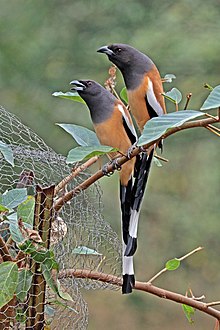Rufous treepie
| Rufous treepie | |
|---|---|

| |
| Pair in Udaipur
| |
| Scientific classification | |
| Domain: | Eukaryota |
| Kingdom: | Animalia |
| Phylum: | Chordata |
| Class: | Aves |
| Order: | Passeriformes |
| Family: | Corvidae |
| Genus: | Dendrocitta |
| Species: | D. vagabunda
|
| Binomial name | |
| Dendrocitta vagabunda (Latham, 1790)
| |
| Synonyms | |
|
Dendrocitta rufa | |
The rufous treepie (Dendrocitta vagabunda) is a
Description
The sexes are alike and the main colour of the body is cinnamon with a black head and the long graduated tail is bluish grey and is tipped in black. The wing has a white patch. The only confusable species is the grey treepie which however lacks the bright rufous mantle. The bill is stout with a hooked tip. The underparts and lower back are a warm tawny-brown to orange-brown in colour with white wing coverts and black primaries. The bill, legs and feet are black.[2]
The widespread populations show variations and several subspecies are recognized. The nominate subspecies is found in the northeastern part of peninsular India south to Hyderabad. The desert form is paler and called pallida, vernayi of the Eastern Ghats is brighter while parvula of the Western Ghats is smaller in size.[2] The form in Afghanistan and Pakistan is bristoli while the form in southern Thailand is saturatior. E. C. Stuart Baker describes sclateri from the upper Chindwin to the Chin Hills and kinneari from southern Myanmar and northwest Thailand.[3] The population in eastern Thailand an Indochina is sakeratensis.[4]
Distribution and habitat
The range of the rufous treepie is quite large, covering Pakistan, India and into Bangladesh, Myanmar, Laos, and Thailand. It inhabits open forest consisting of scrub, plantations and gardens.[1] In the Garhwal Himalayas, it migrates seasonally between different elevations.[5]
Behaviour and ecology
The rufous treepie is primarily an arboreal omnivore feeding on fruits, nectar (of
The breeding season in India is April to June. In Bengal, the peak is in April and May with heightened levels of pineal gland activity and serotonin production.[14] It builds its shallow nest in trees and bushes and usually lays 3-5 eggs.[15][16]
The rufous treepie has a wide repertoire of calls, but a bob-o-link or ko-tree call is most common.[2] A local name for this bird kotri is derived from the typical call while other names include Handi Chancha and taka chor (="coin thief").[13][17]
A blood parasitic protozoan Trypanosoma corvi
References
- ^ . Retrieved 19 November 2021.
- ^ a b c Rasmussen, P.C. & Anderton, J.C. (2005). Birds of South Asia: The Ripley guide. Vol. 2. Smithsonian Institution & Lynx Edicions. p. 595.
- ^ Baker, EC Stuart (1922). "Dendrocitta rufa". The Fauna of British India, Including Ceylon and Burma. Birds. Volume 1. London: Taylor and Francis. pp. 48–52.
- ^ Dickinson, E.C.; Dekker, R.W.R.J.; Eck,S. & Somadikarta, S. (2004). "Systematic notes on Asian birds. 45. Types of the Corvidae". Zoologische Verhandelingen, Leiden. 350: 111–148.
- .
- S2CID 86586782.
- ^ Sharma, S. K. (1992). "Tree Pie Dendrocitta vagabunda (Latham) feeding on aril of seeds of Pithecellobium dulce". Journal of the Bombay Natural History Society. 89 (3): 374.
- ^ Begbie, A (1905). "Curious ferocity of the Indian Tree-pie Dendrocitta rufa". Journal of the Bombay Natural History Society. 16 (3): 502–503.
- ^ Bharucha, E.K. (1987). "An observation on the relationship between a Sambar and a Tree-Pie". Journal of the Bombay Natural History Society. 84 (3): 675.
- ^ Sazima, I. (2011). "Cleaner birds: a worldwide overview" (PDF). Revista Brasileira de Ornitologia. 19 (1): 32–47. Archived from the original (PDF) on 2018-10-18.
- PMID 16615207.
- ^ Krishnakumar, R.; Sudha, G. (2002). "Indian tree pie Dendrocitta vagabunda parvula (Whistler and Kinnear) (Corvidae). A predatory bird of red palm weevil Rhynchophorus ferrugineus (Oliv.)". Insect Environment. 8: 133.
- ^ a b Ali, S. & Ripley, S.D. (1986). Handbook of the birds of India and Pakistan. Volume 5 (Second ed.). Oxford: Oxford University Press. pp. 216–221.
- PMID 2583467.
- ^ Whistler, H. (1949). "The Indian Tree-pie". Popular Handbook of Indian Birds (Fourth ed.). Gurney and Jackson. pp. 12–14.
- ^ Hume, A. O. (1889). "Dendrocitta rufa (Scop.) The Indian Tree-pie". The nests and eggs of Indian birds. Volume 1. London: R. H. Porter. pp. 19–22.
- ^ Finn, F. (1904). "The Magpie". The Birds of Calcutta. Calcutta: Thacker, Spink & Co. pp. 10–13.
- .
- S2CID 85053646.
- S2CID 11066470.
- ^ Duggal, C. L.; Solomon, S. & Ambardar, S. (1986). "On some acanthocephalans parasitizing birds of Punjab". Research Bulletin of the Panjab University (Science). 37 (3–4): 25–31.
- ^ Fain A; Bochkov, A. & Mironov, S. (2000). "New genera and species of quill mites of the family Syringophilidae (Acari, Prostigmata)". Bulletin van Het Koninlijk Belgisch Instituut voor Natuurwetenschappen - Entomologie. 70: 33–70.

